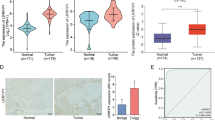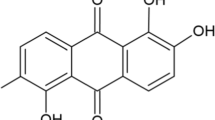Abstract
In order to discover previously unidentified cancer-associated genes, we analyzed genome-wide differences in gene expression between tumor biopsies and normal tissues. Among those differentially regulated genes, we identified Sharpin (Shank-associated RH domain-interacting protein) as a commonly up-regulated gene in multiple human cancer types. Although rat Sharpin is reported to interact with Shank1, a multidomain scaffold protein localized in postsynaptic densities, its exact roles are unknown. Whereas human Sharpin homologue was primarily localized in the cytosol of cultured cells, they were detected in both cytosol and nucleus of the cells from ovarian and liver cancer tissues using immunohistochemical staining. In addition, Chinese ovary hamster cells over-expressing Sharpin exhibited enhanced cancer-specific phenotypes in multiple in vitro tumor assays. Taken together, the results suggest that Sharpin is not an inert scaffold protein, but may play tumor-associated roles during cancer biogenesis.




Similar content being viewed by others
References
Sheng M, Kim E (2000) The Shank family of scaffold proteins. J Cell Sci 113:1851–1856
Lim S, Naisbitt S, Yoon J, Hwang JI, Suh PG, Sheng M, Kim E (1999) Characterization of the Shank family of synaptic proteins. Multiple genes, alternative splicing, and differential expression in brain and development. J Biol Chem 274:29510–29518. doi:10.1074/jbc.274.41.29510
Lim S, Sala C, Yoon J, Park S, Kuroda S, Sheng M, Kim E (2001) Sharpin, a novel postsynaptic density protein that directly interacts with the shank family of proteins. Mol Cell Neurosci 17:385–397. doi:10.1006/mcne.2000.0940
Lee S, Gang J, Jeon SB, Choo SH, Lee B, Kim YG, Lee YS, Jung J, Song SY, Koh SS (2007) Molecular cloning and functional analysis of a novel oncogene, cancer-upregulated gene 2 (CUG2). Biochem Biophys Res Commun 360:633–639. doi:10.1016/j.bbrc.2007.06.102
Butte A (2002) The use and analysis of microarray data. Nat Rev Drug Discov 1:951–960. doi:10.1038/nrd961
Clarke PA, te Poele R, Wooster R, Workman P (2001) Gene expression microarray analysis in cancer biology, pharmacology, and drug development: progress and potential. Biochem Pharmacol 62:1311–1336. doi:10.1016/S0006-2952(01)00785-7
Darnell JE Jr (2002) Transcription factors as targets for cancer therapy. Nat Rev Cancer 2:740–749. doi:10.1038/nrc906
Kreienkamp HJ (2002) Organisation of G-protein-coupled receptor signalling complexes by scaffolding proteins. Curr Opin Pharmacol 2:581–586. doi:10.1016/S1471-4892(02)00203-5
Boeckers TM, Bockmann J, Kreutz MR, Gundelfinger ED (2002) ProSAP/Shank proteins—a family of higher order organizing molecules of the postsynaptic density with an emerging role in human neurological disease. J Neurochem 81:903–910. doi:10.1046/j.1471-4159.2002.00931
Boeckers TM (2006) The postsynaptic density. Cell Tissue Res 326:409–422. doi:10.1007/s00441-006-0274-5
Takai Y, Sasaki T, Matozaki T (2001) Small GTP-binding proteins. Physiol Rev 81:153–208
Seymour RE, Hasham MG, Cox GA, Shultz LD, Hogenesch H, Roopenian DC, Sundberg JP (2007) Spontaneous mutations in the mouse Sharpin gene result in multiorgan inflammation, immune system dysregulation and dermatitis. Genes Immun 8:416–421. doi:10.1038/sj.gene.6364403
HogenEsch H, Dunham A, Seymour R, Renninger M, Sundberg JP (2006) Expression of chitinase-like proteins in the skin of chronic proliferative dermatitis (cpdm/cpdm) mice. Exp Dermatol 15:808–814. doi:10.1111/j.1600-0625.2006.00483
Acknowledgments
This study was supported by the grants, 21C Frontier Functional Human Genome Project (FG09-21-16) and Basic Science Research Program (2009-0067522) by National Research Foundation, and Korea Research Foundation Grant (KRF-2006-331-C00268) funded by Korean Government.
Author information
Authors and Affiliations
Corresponding author
Electronic supplementary material
Below is the link to the electronic supplementary material.
Rights and permissions
About this article
Cite this article
Jung, J., Kim, J.M., Park, B. et al. Newly identified tumor-associated role of human Sharpin . Mol Cell Biochem 340, 161–167 (2010). https://doi.org/10.1007/s11010-010-0413-x
Received:
Accepted:
Published:
Issue Date:
DOI: https://doi.org/10.1007/s11010-010-0413-x




